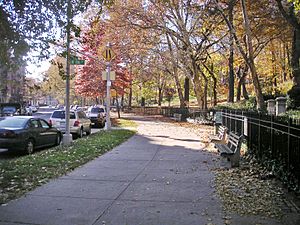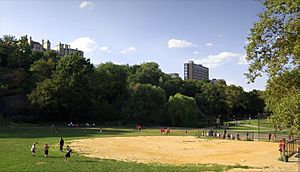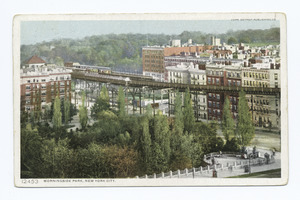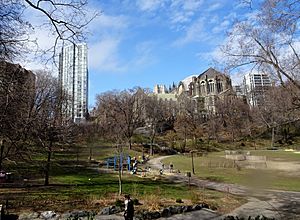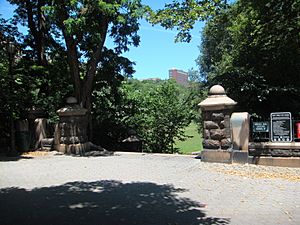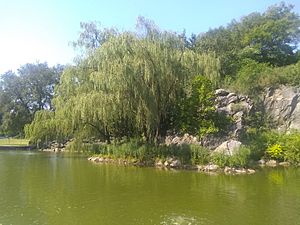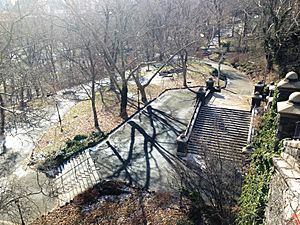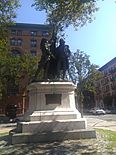Morningside Park (Manhattan) facts for kids
Quick facts for kids Morningside Park |
|
|---|---|
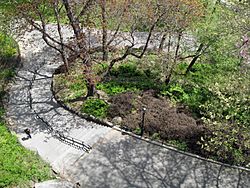 |
|
| Type | Public |
| Location | 110th to 123rd streets in Manhattan, New York City |
| Area | 30 acres (12 ha) |
| Created | 1895 |
| Operated by | New York City Department of Parks and Recreation |
| Open | Year-round |
| Public transit access | Subway: Bus: M3, M4, M7, M10, M11, M116 |
Morningside Park is a 30-acre (12-hectare) public park in Upper Manhattan, New York City. It stretches from 110th Street to 123rd Street. The park sits between Morningside Avenue on the east and Morningside Drive on the west. It creates a natural border between the Harlem neighborhood to the east and Morningside Heights to the west. A big part of the park is right next to Columbia University.
The New York City Department of Parks and Recreation takes care of Morningside Park. The park has a unique natural feature: a tall cliff made of Manhattan schist rock. This cliff separates the higher ground of Morningside Heights from the lower area of Harlem. Inside the park, you'll find rocky areas, a man-made pond with a waterfall, and three sculptures. There are also sports fields, playgrounds, and a special garden called an arboretum.
The land where Morningside Park is now was once called "Muscota" by the Lenape Native Americans. The idea for the park came up in 1867. Famous park designers Frederick Law Olmsted and Calvert Vaux, who also designed Central Park, were asked to create plans for Morningside Park in 1873. After some delays and new plans, construction was finally finished in 1895. Over the years, statues were added, and sports fields and playgrounds were built. In 1963, Columbia University wanted to build a gym in the park. This led to big student protests in 1968, and the gym plan was eventually stopped. Later, the spot where the gym would have been was turned into a beautiful waterfall and pond in 1990. An arboretum was added in 1998.
History of Morningside Park
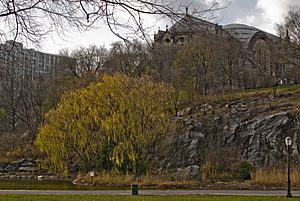
The Park's Location
Morningside Park is built along a cliff that is more than 100-foot (30 m) tall. This cliff separates the high land of Morningside Heights from the lower areas of Harlem. The cliff was formed by earth movements and smoothed by glaciers long ago.
Native Americans called the area "Muscota," meaning "place of rushes." Later, Dutch settlers in the 1600s called the area around the park Vredendal, which means "peaceful dale." The lower lands to the east were called "Flats" because they were marshy. The cliff was an important boundary between Harlem and the higher lands to the west for many years.
During the War of 1812, several small forts, called blockhouses, were built along the cliff in what is now Morningside Park. These forts were never used in battle and slowly fell apart. For a long time, Morningside Heights remained mostly empty, except for a few buildings like an asylum and an orphanage.
Planning and Building the Park
In 1867, a city official named Andrew Haswell Green suggested building a park in Morningside Heights. This would avoid the high cost of building city streets over the very steep land. The city bought the land for Morningside Park in 1868. It cost about $1.33 million.
In 1872, Frederick Law Olmsted and Calvert Vaux, the famous designers of Central Park, were asked to create a plan for Morningside Park. They presented their plan in October 1873. Because of the challenging land, the park was designed to highlight its beautiful scenery and its connection to Central Park. The plan included walkways, a pond, and a retaining wall with stairs. The work was estimated to cost about $816,000.
Starting Construction
Construction on Morningside Park began in 1873, but it was very slow for 14 years due to money problems. By 1875, some walkways were being built, and a sewer and the pond were almost done. Stonecutters were busy preparing stones for the park's walls.
In 1880, Jacob Wrey Mould was hired as the new architect for the park. He created plans for the roads, sidewalks, and walls, including eleven entrances and granite stairs. His plans were approved in 1881. Work continued slowly, with contracts awarded for foundations and entrances. In 1884, it was reported that over $71,000 was needed for the park.
By 1885, stairways on the western side of the park were being built. Local groups were getting frustrated with how slowly the park was being built. After Mould passed away in 1886, the city needed a new architect. In 1887, only one staircase and part of a wall had been finished in 14 years!
Finishing the Park
In 1887, Olmsted and Vaux were asked to work on the park's plans again. They changed the design to fit new conditions, like a nearby elevated train station. Their new plan included wide and narrow paths, a lawn, and a recreation area. The "General Plan for the Improvement of Morningside Park" was approved in October 1887.
By 1888, contracts were given out for filling earth and rocks, and building walls and stairs in the southern part of the park. More money was requested to continue the work. By December 1890, most of the work was almost done. The park was even considered for the World's Fair in 1893, but that didn't happen.
The park's construction was finally completed in 1895. Vaux, who had worked on the project for a long time, passed away that year. Many people felt that Morningside Park was one of his best creations. After the park was finished, many important buildings and colleges, like Columbia University and the Cathedral of St. John the Divine, moved to the Morningside Heights area.
Early and Mid-1900s
After the park was completed, several sculptures and buildings were added. In 1900, the statue Lafayette and Washington was placed in the park. In 1904, a simple restroom building was built.
However, Morningside Park started to have problems. People complained about damage and neglect as early as 1905. The city spent money to fix sidewalks and other issues. In 1914, a fence was put around part of the park.
Another issue came up in the mid-1910s when the city wanted to build a water pumping station in the park. People were upset because the plans were not public. A sculptor even filed a lawsuit to stop the building. Eventually, the city decided to build the pump underground instead.
Improvements continued from the 1920s to the 1960s. In 1929, many plants had to be replanted because they were damaged. By the mid-1900s, some people felt Morningside Park was unsafe. In 1935, a playground and restroom were added. More playgrounds and athletic courts were built in 1935 and 1941. The old restroom was taken down in 1952, and new fences were put up in 1954 and 1962.
Elementary School in the Park
In 1963, the state decided that the northwest corner of Morningside Park would be the site for a new public elementary school. Some people supported this, saying the area was messy and dangerous. Others disagreed, saying the park should only be used for recreation.
Even though some groups opposed it, the city approved the plan in 1964. The school, called PS 36 Margaret Douglas Elementary School, was built between 1965 and 1966. It was the first school in the city designed just for young elementary students (kindergarten to second grade).
Park Cleanup and Today
By the 1960s, Morningside Park was known for being unsafe and dirty. In the late 1970s and early 1980s, groups started talking about redesigning the park. In 1981, some students from Columbia University started the Friends of Morningside Park group. They wanted to bring the park back to its original design.
NYC Parks made plans for a $12-million park restoration between 1987 and 1989. Columbia University also gave money for the project. The first part of the renovation began in 1989. It turned the big hole left by the canceled gym project into a beautiful waterfall and ornamental pond. This pond was part of Olmsted and Vaux's original plan. This first phase of renovation, which also included new playgrounds, trees, and sports fields, was finished in 1993.
More renovations happened in the late 1990s. The stairs at 116th Street were rebuilt from 1996 to 1998. In 1998, the Dr. Thomas Kiel Arboretum was started in the northern part of the park. This arboretum was named after one of the founders of the Friends of Morningside Park. By 2001, the park's condition had greatly improved, and it was no longer seen as dangerous.
Since then, more improvements have been made. Several stairs and entrances were rebuilt, and playgrounds were renovated. The sports fields and northern part of the park were restored in 2006. Morningside Park was named a New York City landmark in 2008. More trees were planted in 2009, including a giant sequoia tree.
What You Can Find in Morningside Park
The park was designed by Frederick Law Olmsted and Calvert Vaux. Over the years, playgrounds, basketball courts, and softball fields have been added.
Fun Things to Do
Morningside Park has several sports areas. You can find two baseball fields and a basketball court at the south end. There are three more basketball courts in the middle of the park. In the north, there are two basketball courts and four handball courts.
There are also playgrounds for kids at 110th, 113th, 116th, and 118th Streets, located at the bottom of the cliff. A restroom is available at 123rd Street.
The Morningside Dog Run is a fenced area where dog owners can let their dogs play. It has two sections and is covered with wood chips. You can easily get to the dog run from 114th Street on the east or 114th or 116th Streets on the west. There's also a barbecue area at 121st Street.
The Kiel Arboretum is in the northern part of the park, from 116th to 121st Streets. An arboretum is like a tree museum, with many different kinds of trees and shrubs. This arboretum was built in 1998, based on old plans by Olmsted and Vaux for Central Park. It has trees from the Magnoliaceae (magnolia) family and shrubs from the Ranunculaceae (buttercup) and Berberidaceae (barberry) families.
Over the years, many playgrounds have been built in Morningside Park. As of 2019, there are four playgrounds. The first one was built in 1903–1904 and later removed. A playground in the northeast corner was built in 1935 and has been updated many times. Another playground, built in 1955–1956, has shuffleboard and basketball courts, a wading pool, swings, slides, and a sandbox. There are also play areas at 113th Street and 110th Street. A new playground opened in 2008.
Park's Natural Features
Morningside Park is famous for its rugged cliff made of Manhattan schist rock. This type of rock is found under much of Manhattan. You can see many rock outcroppings (parts of rock that stick out of the ground) in Morningside Park, just like in nearby Central Park. There's also a special glacial groove (a mark left by glaciers) at 121st Street.
The eastern side of the park used to have a flat area, but much of it was dug up for the Columbia University gym project that was never finished. Today, this spot has a beautiful waterfall and a pond, built between 1989 and 1993. The waterfall is man-made and uses water pumped from the city's water system. You might see birds like great blue herons and red-winged blackbirds, and animals like painted turtles and mallard ducks around the pond.
In its early years, the park had several open grassy areas called meadows. These were later turned into playgrounds and sports fields in the mid-1900s. Today, the southern meadow has sports fields, while the central and northern meadows have playgrounds.
Paths and Plants
Morningside Park has many paths and planted areas. The paths usually follow the natural shape of the land. In some places, stone steps connect paths at different levels. The paths were originally made of gravel, concrete, and asphalt. Benches, lights, railings, fences, and stone walls have been added over time.
The plants in Morningside Park have been added at different times. Some early reports said the area was "barren," while others said it had "native growth" like vines and shrubs. Over the years, plants were damaged by people and erosion. Big landscaping projects took place in 1929, 1941, 1962, and 2006 to keep the park beautiful.
Art in the Park
There are three sculptures in Morningside Park.
The first is the Lafayette and Washington statue (1900) by Frédéric Auguste Bartholdi. It's located at the triangle where Manhattan Avenue, Morningside Avenue, and 114th Street meet. This statue celebrates the friendship between the U.S. and France during the American Revolutionary War. It shows General George Washington and the Marquis de Lafayette holding hands. It's a copy of a statue in Paris, France.
The second is the Carl Schurz Monument (1913), with a statue by Karl Bitter. It stands on a brick plaza at Morningside Drive and West 116th Street. The monument features a bronze statue of politician Carl Schurz in the middle of a curved granite wall. The wall has carvings that show Schurz fighting against slavery and for better treatment of Native Americans.
The third is the Seligman (Bear and Faun) fountain (1914) by Edgar Walter. It was dedicated in memory of Alfred L. Seligman. This 7-foot-tall (2.1 m) fountain shows a grotto (a small cave) with a bear hanging above it. Below, a faun (a mythical creature) is playing pipes. The fountain also has a drinking fountain for people and a basin for dogs to drink from.
Streets Around the Park
Morningside Park is mostly rectangular. The sidewalks around the park are made of Belgian blocks and concrete, and they have trees.
The western side of the park is along Morningside Drive. This road is on top of a large retaining wall that drops steeply down to the park. The wall has stone supports and a fence made of granite posts and iron. At most intersections with Morningside Drive, there are "overlook bays" or balconies that hang slightly over the park. From this side, you can enter the park at 112th, 113th, 114th, 116th, 118th, 120th, and 122nd Streets, with stone stairways leading down.
The southern side of the park is West 110th Street, also called Cathedral Parkway. There's an entrance here that leads to a stone stairway.
The eastern side of the park is along Manhattan Avenue (from 110th to 113th Streets) and Morningside Avenue (from 113th to 123rd Streets). There's a wrought-iron fence along this side.
The northern side of the park is West 123rd Street, also with a wrought-iron fence.
How the Park is Managed
Morningside Park is owned and managed by the New York City Department of Parks and Recreation. There's also a group called Friends of Morningside Park, which is a nonprofit organization. This group was started in 1981 to help keep the park looking good and to support its original design.
The Friends of Morningside Park group helps by organizing volunteer work and getting donations for staff and equipment. They organize many public events in the park, like festivals and concerts. As of 2005, they had about 1,000 volunteers.
The Central Park Conservancy, which takes care of nearby Central Park, also helps Morningside Park. Since 2005, they have provided support for gardening and maintenance, and they train staff for Morningside Park and other parks in Harlem.
See also
 In Spanish: Parque Morningside (Nueva York) para niños
In Spanish: Parque Morningside (Nueva York) para niños


